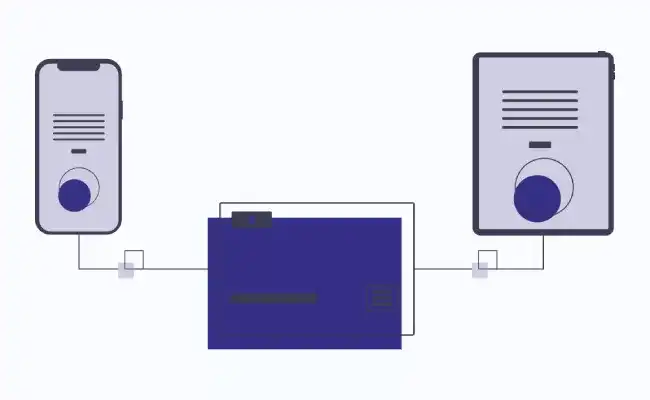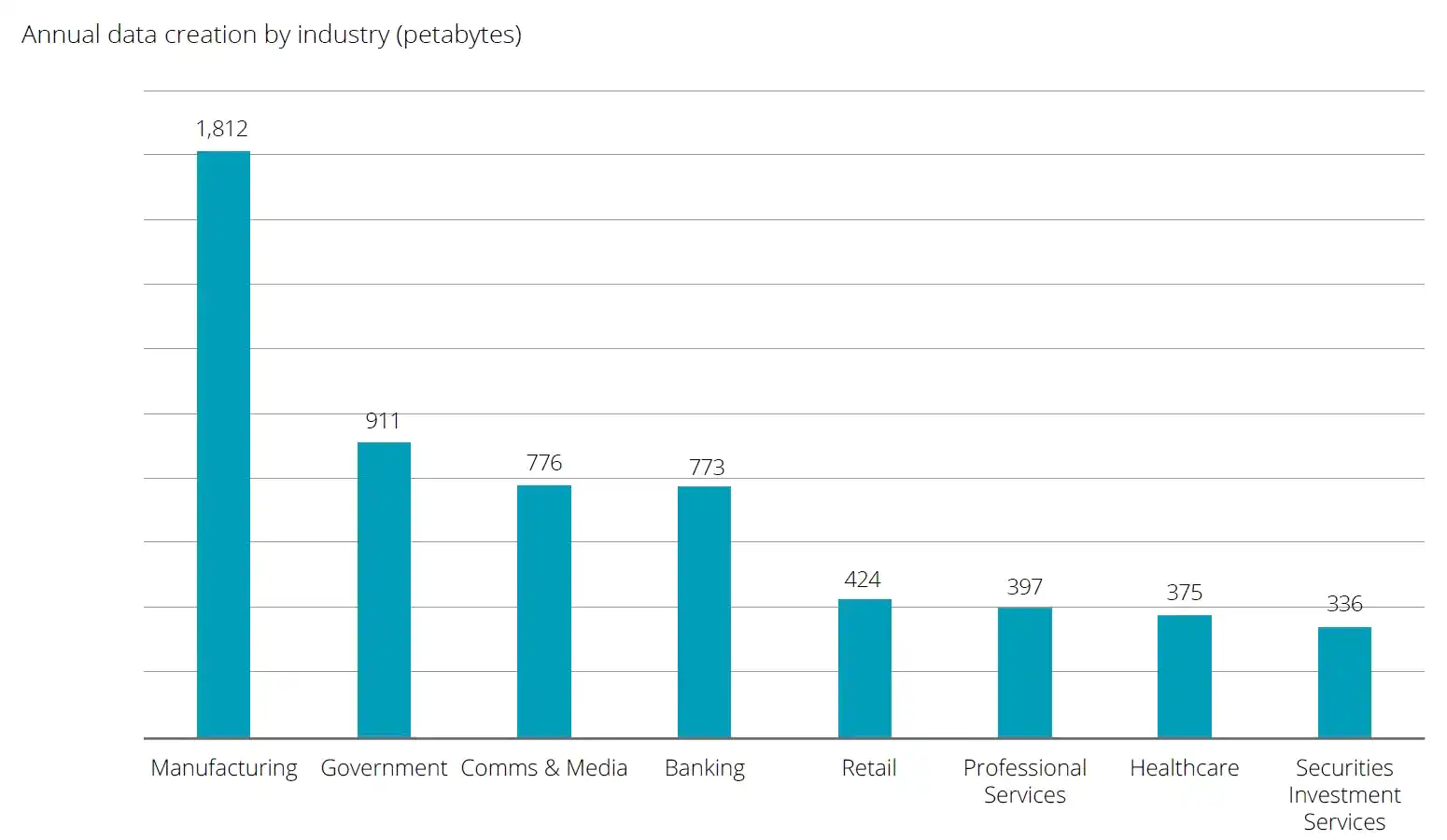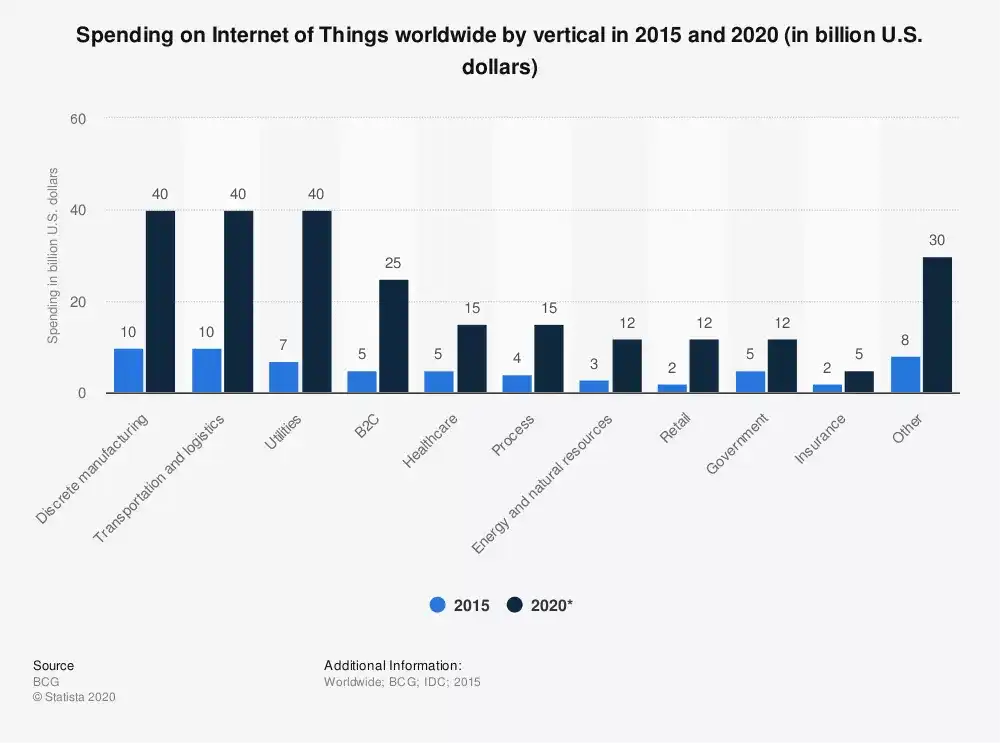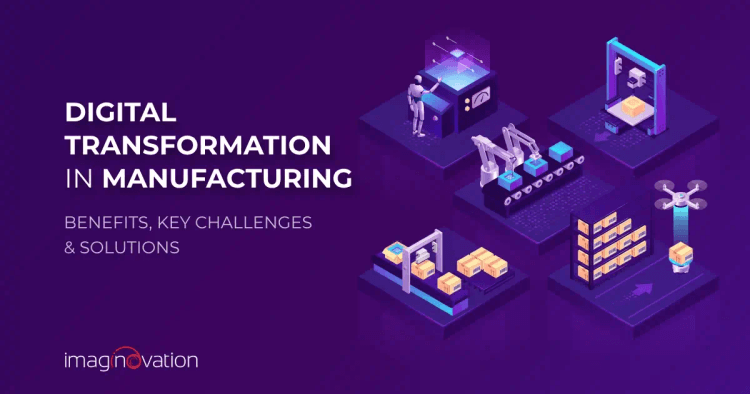Manufacturing is undergoing a digital revolution, and it's no surprise why.
Increased customer expectations, technological advancements, and innovation push are some of the most significant drivers for the ongoing digital transformation in manufacturing.
As a result, many companies have started recognizing the long-term benefits of digital transformation.
If you, too, plan to embrace this wave of digital transformation and go digital, you can benefit greatly from this trend.
Let's find out how you can unlock the potential of digitalization and position your manufacturing company for success with enhanced efficiency and overall cost reduction.
Let’s read on.
The Evolution of Manufacturing in the Digital Age
The evolution of manufacturing has been a long and tumultuous one, but it's never been more exciting than it is today.
After years of relying on traditional methods, we're finally at a point where digital technologies are transforming how we do business and make things.
The once-humble industry has gone from a slow, manual process of making things one at a time to a digital system that can produce thousands of items daily.
But what exactly happened? How did we get here?
Let us go back in time and examine the history of manufacturing.
The manufacturing revolution began in the 18th century with the Industrial Revolution. Machines and steam power changed everything, leading to mass production and shaping the modern world.
The next century brought assembly lines, starting the Second Industrial Revolution and boosting mass manufacturing like never before. This development and the rise of electricity led to increased efficiency and productivity.
The mid-20th century witnessed the integration of computers into manufacturing. Automation and computer numerical control (CNC) machines replaced manual operations, improving precision and efficiency.
However, the digital age truly arrived in manufacturing in the early 21st century. IoT, AI, robotics, and data analytics brought a new era of advanced manufacturing, making way for smart factories.
The advent of IoT enables the connection and communication of physical devices and machines. Sensors embedded in machinery and products collect real-time data, allowing manufacturers to monitor performance and optimize processes.
AI technology also plays a critical role in the digital age. AI algorithms and machine learning enable machines to analyze vast amounts of data, make informed decisions, and perform complex tasks with minimal human intervention.
Robotics have become integral to modern manufacturing operations. Collaborative robots (cobots) work alongside human workers, performing repetitive tasks, handling heavy loads, and ensuring precision in assembly and production.
This excellent combination of human skills and robotic capabilities enhances productivity and worker safety.
Additionally, 3D Printing, also called additive manufacturing, has revolutionized conventional production techniques. It offers enhanced design flexibility, minimal material waste, and facilitates quick prototyping.
Industry 4.0, or the fourth industrial revolution, today represents integrating cyber-physical systems into manufacturing, blurring the lines between the physical and digital realms.
Why Manufacturing Companies Should Invest in Digital Transformation?

Digital manufacturing is a wonderful concept. Here are six ways you could benefit from working digitally:
1. Improve efficiency & productivity
Investing in the right digital strategy can improve work efficiency and productivity drastically for you. Moving away from traditional manual processes and deploying automated, cloud-based solutions can help:
- Streamline processes
- Improve decision-making capabilities
- Avoid costly rework and downtime
- Simplify performance monitoring
- Identify weaknesses and bottlenecks
- And pre-test new ideas before implementing them
This way, your business can save a huge amount of time and money while also using employee time more effectively.
You can explore the use of technologies such as:
- Online paperwork
- Automatic stock replenishment
- Factory virtualization
- E-sourcing
- Digital planning and processing tools
- Remote communication software
- And online collaboration to digitize work

2. Reduce costs
Digital manufacturing can help you gain better insight into issues such as inventory levels, delivery status, and demand cycles.
You can be in a better position to make informed decisions and deal with irregularities of demand and supply. This will reduce unnecessary risks and costs related to things like excessive inventory, inventory, and material.
3. Innovate
You will never regret investing in the digitization of your manufacturing company. It’ll be worth it to invest in the right digital infrastructure, technology, and software, as it will empower your employees with unique and improved technology, taking a step towards modernization.
Moreover, technology makes room for collaboration by connecting users, sharing vital information, remote meetings and conversations, greater idea generation, and accelerated development. This can transform your entire business.
4. Customization
Digitized manufacturers can offer customers attractive customization options. It can allow manufacturers to operate on a mass scale while maintaining high efficiency. This will ultimately help in keeping the prices competitive.
5. Safety
Robots can handle work in dangerous environments. The manufacturing staff can be alerted about potential hazards well in advance, thanks to the sensors deployed throughout the plant.
6. Attract and empower the next generation workers
By investing in digitization, there’s a better chance of you attracting and retaining skilled workers.
Challenges and Solutions in Digital Transformation
Digitization makes your company future-ready. It brings about numerous opportunities for manufacturing companies, but it also presents unique challenges.
Here are a few common challenges and some potential solutions to consider -
1. Lack of digital expertise.
Digital transformation in manufacturing needs both skills/talent and technology. Even non-tech roles these days need some basic tech know-how.
Manufacturers often struggle to find employees with digital expertise for transformation initiatives.
This includes data analytics, AI, IoT, cybersecurity, and cloud computing skills. Leveraging digital technologies and achieving desired outcomes can be challenging without this expertise.
Unfortunately, due to a limited pool of skilled employees in this field, finding suitable candidates is tough and costly.
To address this challenge, you can consider the following strategies:
Solution
One thing is certain: you'll require the right team or training to equip your workforce with digital literacy and innovative skills.
To implement advanced technologies like data analytics, AI, machine learning, digital twins, and automation in your manufacturing processes, ensure you adopt best practices and effective strategies.
Since each company's needs vary, choose software solutions that align with specific requirements.
2. Initial capital investment
When considering the digital transformation of your manufacturing processes, one question arises: How much capital is needed?
After all, it's a big investment that needs careful planning before diving in.
Implementing digital technologies and upgrading existing infrastructure requires financial resources. You'll need funds for hardware, software, training, consultancy, and infrastructure upgrades.
Understandably, the initial capital expenditure can be a concern.
Solution
When planning digital transformation in manufacturing, estimate upfront costs and potential revenue post-transformation.
Consider urgency, impact, risks, and financial capacity. Allocate funds strategically among departments based on their post-transformation value.
Calculate expected revenue and savings for future planning. Make sure the total expenditure aligns with your company's futuristic goals.
3. Resistance to change
Digital transformation in manufacturing often involves systemic changes to processes and procedures, which may disrupt the existing ways of doing things.
This is often met with resistance from employees who are accustomed to the current way of working.
Moreover, digital transformation can disrupt established power structures within the organization. This leads to resistance from employees who perceive the changes as a threat to their job security.
Additionally, there may be a lack of understanding or skills required for the new technologies, which can create an aversion to change.
Solution
Do the following to address this challenge of resistance to change.
Communicate and educate your employees accurately and in a timely manner. Explain why change is necessary and educate them of the potential benefits of going digital to overcome fear and skepticism. This will help you gain their buy-in.
Involve your employees in the change process by seeking their input and inquiring about their views. This will make them feel informed and help achieve their buy-in for the changes.
In addition, provide sufficient training and support to your employees to minimize resistance that may result from introducing new tech.
Lastly, consider implementing changes gradually. This approach will be less intimidating for your workers, allowing them to adjust to the digital transformation process comfortably.
4. Legacy Infrastructure and Systems
Some basic requirements for digital transformation in manufacturing include cloud infrastructure, new-age computers, lots and lots of data processing, and superfast Internet.
However, many manufacturing companies have older systems and infrastructure that don't mesh well with modern digital technology.
Because these systems are outdated and rigid, they may lack the necessary connectivity, interoperability, and scalability for seamless integration into a digital ecosystem.
Solution
To address this issue, you may need to gradually prioritize which systems need upgrading first. Don’t start the entire digitization in a single go.
Cloud-based solutions can also be helpful in seamlessly integrating new technology with existing infrastructure.
You can also consider partnering or collaborating with technology providers who can help with integration.
5. Siloed digitization attempt
When different departments tackle digital transformation initiatives separately, coordination issues can arise. This approach often makes it challenging to scale the transformations company-wide.
Moreover, operating in silos hampers smooth process integration, data sharing, and collaboration, all crucial for successful digital transformation in manufacturing.
Solution
Encourage cross-functional collaboration and break down silos. You can do this by involving all stakeholders from various departments in the digital transformation journey.
Implement a unified digital strategy and align it with the overall business objectives. This ensures a cohesive approach to transformation.
Additionally, invest in robust change management processes and training programs to promote a digital mindset across the organization.
6. Cybersecurity issues
Cybersecurity is a significant concern for digital transformation in manufacturing. Since the sector is a prime target for cyberattacks, prioritizing cybersecurity becomes crucial during this transition.
During digital transformation, various systems, technologies, and devices become interconnected, creating potential vulnerabilities exploited by cybercriminals.
Successful cyberattacks in manufacturing can lead to severe consequences, including operational disruptions, production downtime, compromised supply chains, and reputational damage.
Solution
A sound cybersecurity plan is crucial for a manufacturing company's effective cybersecurity. This should not only improve cybersecurity protocols but also address future risks.
To develop a cybersecurity strategy, consider the following points:
- Figure out which critical information assets require protection.
- Understand how information flows in the entire organization.
- Identify the potential risks that can occur if the information is lost or compromised.
This will lay the groundwork for how your company addresses the risks. You can then assign roles, develop safe procedures, and implement necessary measures to bolster cybersecurity.
7. Return on Investment (ROI)
Calculating the return on investment (ROI) for digital transformation in manufacturing can be challenging for several reasons.
Firstly, the complexity of ROI calculation comes into play. Digital transformation involves numerous changes across processes, systems, and technologies, making it difficult to isolate the specific impact of each transformation initiative on financial returns.
The long-term perspective also adds to the challenge. Digital transformation initiatives often require significant upfront investments in technologies, infrastructure, and skills development. The full ROI may not be realized immediately, and achieving the desired financial outcomes may take time.
Thus, quantifying the ROI in the short term can be challenging, especially when considering the evolving nature of digital technologies.
Solution
You can establish measurable objectives and KPIs to address these challenges, develop robust measurement frameworks, and leverage industry best practices.
By understanding the complexities, taking a long-term view, considering both tangible and intangible benefits, and implementing suitable measurement practices, manufacturing companies can better understand the ROI of their digital transformation efforts.
How Leading Manufacturers Are Driving Digital Transformation?
Before embarking on your transformation journey, let's look at the following incredible success stories and gather inspiration from these experts in the manufacturing industry.
1. Cisco
Cisco has always outsourced most of its manufacturing to contract manufacturers. Although outsourcing has several benefits, it also poses the challenge of controlling outsourced production processes, especially product quality.
To manage this challenge, Cisco developed a “virtual” MES (manufacturing execution system) platform or VMES, providing real-time supply chain quality visibility.
The VMES shares real-time supply chain data and covers three fundamental aspects of outsourced production operations: traceability, transformation, and testability.
2. Polaris
Polaris is known worldwide for its snowmobiles and all-terrain vehicles (ATVs).
To deliver a superior end-to-end experience to its customers, including customized purchase options and enhanced safety features, Polaris digitized to change how it designed, manufactured, and serviced its products.
Polaris adopted a phase-wise approach to digital transformation with PTC as a key partner. Starting with product lifecycle management (PLM) and extending the platform through IIoT to augmented reality.
Gaining visibility throughout the product lifecycle – from concept to product design to manufacturing to real-world use – was critical to the digital transformation journey.
3. Lavifood
Lavifood is a Vietnamese company that provides fresh vegetables, fruits, and agricultural products to global markets.
The company has started using a suite of technologies to achieve digital transformation.
Right from integrating IIoT, higher connectivity, and real-time analytics, the company has explored different ways to digitize its processes, provide dynamic responses to issues, and reduce downtime, all of which ultimately lead to improved product quality.
Digital Transformation Trends in Manufacturing
It’s an inspiring time for the manufacturing industry because Industry 4.0 is still in process. Many companies are shifting gears with the use of advanced technology to automate their manual processes.
Honestly, the year 2023 continues to follow the digital transformation trends set in this area in the last few years. The difference lies not so much in the kind of technology being used but more so in the increased number of companies going digital.
Let’s take a look at the seven most-followed digital transformation trends to watch for in 2023.
1. Machine Learning and AI
AI or Artificial intelligence is all about the creation of intelligent software or hardware, which is able to replicate “human” behaviors such as learning and problem-solving.
We know that the biggest asset for any company going digital is its data. Keeping in mind the amount of data collected by the machines, it becomes vital to use algorithms to perform quick actions – something that cannot be done as efficiently, quickly, and accurately by us humans.
‘Data quantity’ and ‘computing power’ have thus become the two significant reasons to deploy Artificial Intelligence-led technologies in your manufacturing company. And it’s what will make your manufacturing more productive and less wasteful.

2. IIoT
The Internet of Things, or IoT, is the network of different physical objects embedded with software. It’s a network of interconnected sensors and electronic devices that gather and exchange data.
Aren’t we all familiar with such products in our homes in the form of Digital voice-based assistants like Alexa, or smart TV, lightbulbs, and thermostats?
Similarly, the IIoT or the Industrial Internet of Things, has machines on the manufacturing floor, networked via the Internet. The system collects data to drive AI and perform predictive analytics.
IIoT is transforming the manufacturing industry big time. It is helping change the way products are made and delivered.
According to the survey, roughly 63% of manufacturers believe that implementing IoT will increase profitability over the next five years.
As compared to 2015, when IoT spending worldwide in discreet manufacturing amounted to 10 billion U.S. dollars, in 2023, it has grown four times to 40 billion U.S. dollars.

3. 5G and Smart Manufacturing
Everyone has been talking about 5G in the last few years. But this year is crucial because 5G has finally entered the world of manufacturing.
Industry 4.0, or the fourth industrial revolution, is ushering in an era of smart factories with connected devices, which can interoperate with one another and make decentralized decisions. However, this transformation is not possible without 5G.
This fifth-generation mobile network is faster and more powerful, capable of handling the full integration of the IIoT in a smart factory. 5G’s high capacity, wireless flexibility, and low-latency performance make it a default choice to support manufacturers.
Some companies are already testing it. Audi, the automotive company, has already implemented 5G to support its robotics, cutting 30% to 50% off of its delivery time.
(Source: Manufacturing Industry Trends for 2020 by Beekeeper)
4. 3D Printing Technology
3D Printing is a much talked about digital transformation technology in the manufacturing industry. The use of this technology helps companies make faster and cheaper prototypes. In fact, innovations in this field have almost halved costs while delivering twice the performance.
It’s a cost-effective way for item designers to troubleshoot and test their commodities. It also helps industrial manufacturers to produce commodities that are in high demand.
The aerospace and automotive manufacturing industries are already making good use of this technology.
5. Predictive Maintenance Innovation
The manufacturing industry has always relied upon the use of technology. As per a survey by ITIC in 2019, 86% of manufacturing firms state that a single hour of downtime can cost at least $300,000. As businesses move towards “always-on” and staying interconnected, these numbers are likely to go up now.
In the past, manufacturers would schedule routine maintenance on equipment to check for any unnoticed malfunction. But this, too, would result in halted production and cost money.
Now, with the investment in digital technology, machines are developed with internal sensors that send messages to notify workers if maintenance is required. With a real-time alert and response system, the technology of predictive maintenance catches mechanical failures even before they happen.
Now! Isn’t that cool?
6. Next Generation Manufacturing Employees
This one’s about people and skills.
It’s evident that as technology takes over much of the repetitive work, many traditional manufacturing jobs will phase out. Also, with an increased supply chain demand, companies are automating operations to speed up production.
Now, I am not saying that jobs will disappear from the industry. In fact, humans will still remain at the heart of the manufacturing industry. It’s just that they will need new skills. Some of the in-demand jobs will be:
- Data analysts
- Software engineers
- Programming for IoT, robotics, and automation
- Customer service
- R&D, product development
- Sales and marketing
As the scope of their jobs shifts away from traditional hands-on manufacturing, the workers will need to develop new skills.
7. Agility and Responsiveness
The biggest advantage is that technology is making our manufacturers focus on improving responsiveness and agility because of changing customer demands and market conditions.
If we can reduce the time it takes us to create, receive, schedule, and process a client’s order, there is nothing like it.
This is beneficial to manufacturing companies. They will be able to match production cycles and emerging product demand levels closely. The more successfully an organization can match those two essentials, the more agility it can pump into their operations.
How Leading Manufacturers Are Driving Digital Transformation?
Before embarking on your own transformation journey, let’s take a look at the following incredible success stories and gather inspiration from these experts in the manufacturing industry.
1. Cisco
Cisco has always outsourced most of its manufacturing to contract manufacturers. Although outsourcing has several benefits, it also poses the challenge of controlling outsourced production processes, especially product quality.
To manage this challenge, Cisco developed a “virtual” MES (manufacturing execution system) platform or VMES, which provides real-time visibility to supply chain quality.
The VMES shares supply chain quality data in real-time and covers three fundamental aspects of outsourced production operations: Traceability, Transformation, and Test.
2. Polaris
Polaris is known worldwide for its snowmobiles and all-terrain vehicles (ATVs).
With an aim to deliver a superior end-to-end experience to its customers, including customized purchase options and enhanced safety features, Polaris digitized to change the way it designed, manufactured, and serviced its products.
Polaris adopted a phase-wise approach to digital transformation with PTC as a key partner: Starting with product lifecycle management (PLM) and extending the platform through IIoT to augmented reality.
Gaining visibility throughout the product lifecycle – from concept to product design to manufacturing to real-world use – was a critical part of the digital transformation journey.
3. Lavifood
Lavifood, is a Vietnamese company that provides fresh vegetables, fruits, and agricultural products to global markets.
The company has started using a suite of technologies to achieve digital transformation. Right from integrating IIoT, higher connectivity, and real-time analytics the company has explored different ways to digitize its processes, provide dynamic responses to issues, and reduce downtime, all this ultimately leading to improved quality of products.
Drive Digital Transformation in Your Manufacturing Plant with Imaginovation
An excellent approach to launching a digital transformation in manufacturing is to identify improvement opportunities that will significantly benefit the customer.
Are you ready to take the next step toward getting a digital transformation? If you want to build an incredible smart manufacturing unit that can help improve your business process and facilitate growth, then get in touch with us.
We are an award-winning web and mobile app development company with vast experience in crafting remarkable digital success stories for diverse companies. Let's talk
Ready to build an app, but not sure where to start?
We've got you covered. Click the button below to get started.





